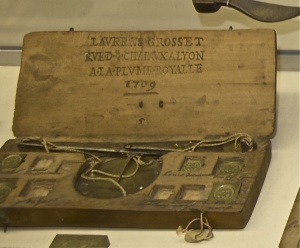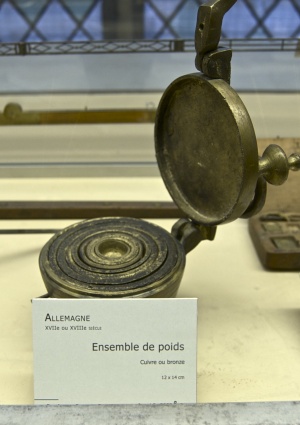STS3301 Paper Week 2
Response to Week 2 Readings in Making Modern Science, for STS 3301

As we have begun to delve into parallels between enlightenment's epistemological issues and those of today, I catch glimpses throughout the readings of several more. Can I save future historians some time by compiling indicators of what science we culturally allow today? Or would they not trust me?
There are certain themes that shine from the readings: standardization, intentional social change, theory vs. practice, nationalism, acceptable or taboo science, revolution, the classification of people, and indoctrination. Some themes from last week's reading are now mere ripples: Self-aggrandizement and universal truth, although the latter seems to be the intentional mascot of this course. And, as I read the newspaper and the parade of incensed commenters to online articles about science, all these themes inform my reading of today's issues.
On Standardization
Reading Ken Adler's A Revolution to Measure, I thought of our own National Institute of Standards and Technology. The first thing I saw going to their web page was their motto "...working with industry to foster innovation, trade, security and jobs." So, a public-private partnership, like the Iraq counterinsurgency or the Postal Service. Does it mean something that NIST gets a .gov url, while USPS gets a .com? NIST is an agency of the Department of Commerce, the USPS is an independent establishment of the executive branch. NIST is currently helping microelectronics engineers better measure tiny electronic circuits so that companies like Intel can compete globally.

Alder implies in a parenthesis on 49 that the geodetic standard for a meter might have been chosen because it would line the wallets of scientists. Is our time of public-private partnerships any different? NIST is a government entity with an avowed commitment to its "customers," the scientific, engineering, and technological community, all mainly private. [ http://www.nist.gov/public_affairs/nist_mission.htm ]
I also thought of the metrics used in a spring Ithaca Times article about wind power in the county. It told of the confusion wrought by a developer's choice of units for describing the potential power output of the development. His calculation, an attempt to show how significant the power would be to the region, led people to disbelieve his gist no matter what the units. [Looming Large by Taryn Thompson in Ithaca Times, May 20-26, 2009.] "'At 100 percent peak production, the wind farm will power all of the residences in Tompkins County...The wind farm will produce 50 megawatt-hours, but the electricity from these wind mills will not actually for sure go into every residence in the county. I'm saying they'll power the equivalent amount of energy, to give people an idea,' [the developer] said, adding that his statement was a way of phrasing the situation in comprehensible terms, in a way that people would understand."
On Acceptable or Taboo Science

Maupertuis wrote to Bernoulli on his more controversial paper "I do not at all wish to read this piece in our meetings where there are people who are shocked simply by the word 'attraction'" [quoted in Terrall, p. 58]. Anthropogenic global warming to some, intelligent design to others, are two such shocking phrases in science today. Evidence for the shock factor can be seen in the strong words people use in comments on newspaper articles about AGW. Maupertuis wrote that the reason for his reticence in Paris was not political, just appropriate to the level of acceptability of Newton's system. But there is no fertile soil of acceptability without a plow of revolution. Maupertuis' horse to draw that plow was his tenure, at least as Terrall presents it. [pp. 60,61]
Fontenelle, described by Terrall, could not reason with Newton's conclusion that the planets acted on each other directly, at a distance. To him, science needed to to be "clear and distinct," not "chaos." [pp. 72, 73] But when empirical evidence came from the Meridian team against Newton, Fontenelle claimed to prefer the evidence to simplistic geometric theories "from which one has purposively separated off all the complexity of physics and reality." Is it the hypocrite that always loses?
On Revolution

Going over Maupertuis' travel itinerary, Terrall is careful to point out that Maupertuis' social visit to England was not a direct influence on his stance on cross-channel debates, but may have laid some ground for his more independent thinking.[Terrall, pp. 42, 43] The mathematician later travels to Basel with the explicit intent of being influenced by the elder Bernoulli, but through his own revolution, over decades, wedges into the Parisian academy some of the very ideas Bernouilli decried.
Terrall echoes Crosbie's point that a community is "crisscrossed by ties of intellectual patronage and mentorship." [Terrall, p. 37]
Maupertuis was able to see beyond any single "solution to a puzzle." "The calculation answers not only the question we put to it, but it also teaches us that the question has a broader meaning than we had thought, and it answers the whole thing," she quotes from "Sur une question de maximus et minimus." This from him at an early age, we can see how Maupertuis might be one to appreciate working with the vanguard of mathematical investigators, and how he might come to a position above the vis viva/momentum debate. Maupertuis might be the agent of Kuhn's Normal Science begetting its own overthrow.
Terrall concludes that the vortex-including paradigm begat its own demise, through the mathematical refinements to Bernoulli's paradigm-defining work. [p. 82]
On Indoctrination
Alder's "Social Epistemology of Enlightenment Engineering" is a detail of indoctrination, covering the structure of the schools, the appointment of new hierarchies, and the appropriation of concurrent movements like standardization. The French could be said to be experimenting with meritocracy, an idea we'll see again in the period 1880-1900 when professional societies coalesce in America, but the upwardly mobile doctors, lawyers, and engineers therein refuse otherwise meritorious women for "social" reasons.
The particular doctrine seemed to be "be practical and innovative, but utilitarian over philosophical." The exacting standards led to a culture familiar in oversized engineering introductory courses as the "look to your left, look to your right, only one of you three will graduate in this major" kind of pipeline. The artilleryman's schools might have been the first place where extra math homework was the standard punishment. [pp. 65,66] With the indoctrination made explicit, administrators could hold standardization of the curriculum more important than innovation, thus the exiling of Bélidor in 1732. The doctrine and the standards combined to make what we recognize as the modern engineering textbook (and I also recognize in science textbooks): Theoretical propositions followed by a problem set that "applies" the theory to "physical realities."
On the Classification of People
I followed with interest the story of the introduction of a new class of officers by the Gribeauvalists, garçon-major, available to non-commanding officers, taken from the middle classes. [Alder SEEE, pp. 78,79] The artillery schools created an "engineering for non-majors" [my pun] course, "careful to give the sergeants only as much 'theoretical principles' as was consonant with their social status and function." In this way resonant with "physics for poets" and the multiple tracks for different classes of students at Cornell U.